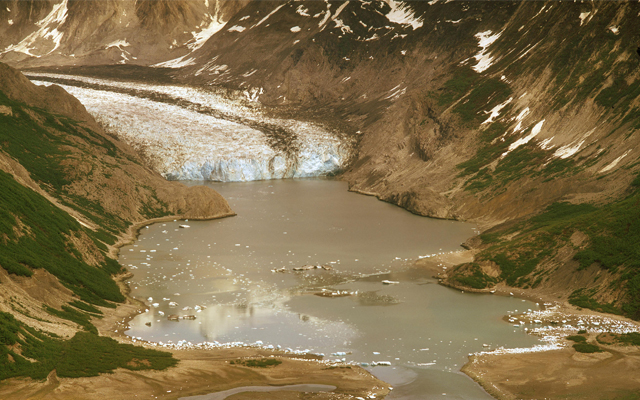
by John Copeland Sunday, October 5, 2014

credit: Michael Collier.
It intrigues me how geography — a product of dynamic processes shaping Earth’s surface — influences our lives, culture and even plays a hand in the affairs of nations. Take, for example, the last glacial maximum, which shaped parts of North America roughly 20,000 years ago, and in doing so contributed to factors that eventually led to the American Civil War.
The unique, glacially crafted geography of the first two permanent English settlements in America — Jamestown and Plymouth — substantially impacted the growth and development of each. Yet the impacts differed greatly between the two, helping lead to fundamental cultural differences that ultimately became issues of contention in the Civil War.
Jamestown lies in the Tidewater region of Virginia. During the Pleistocene, glaciers grew and advanced southward, and as sea levels fell, rivers issuing from the Appalachians eroded Virginia’s soft coastal plain sediments, forming deep valleys east of the Piedmont. When the glaciers retreated again and sea levels rose, these river valleys flooded, creating bays and estuaries that would become navigable as far inland as the Piedmont.
In the spring of 1607, three small ships carrying 104 men landed at the mouth of the James River. Most were gentlemen-adventurers — lured to the New World by the promise of easy riches — who knew little about farming, hunting, cooperative living or selecting a suitable location for settlement. The site chosen for Jamestown, in briny marshlands, was well suited for defense but less so for agriculture.
The settlers were more interested in finding gold and silver than in farming, and life for Jamestown’s residents degenerated during a several-year period they called the “Starving Time.” By the spring of 1610, only 10 percent of the colonists remained when ships arrived with food, supplies and a few Caribbean tobacco plants. The colonists soon discovered that Virginia’s climate and soil were ideal for cultivating tobacco. And rising demand for tobacco in Europe changed everything.
The Tidewater’s geography, with innumerable creeks, inlets, coves and river mouths, afforded the colonists easy travel by water and little need for roads. They founded large, self-sufficient tobacco plantations along the rivers, giving birth to a plantation society.
Growing tobacco was both hard on the soil and labor intensive. Besides the large acreage needed to maintain their crops, plantation owners needed inexpensive labor, and the first African slaves arrived in Jamestown in 1612. Virginia planters sold their tobacco directly to England — loading it aboard ships that could sail upriver directly to each plantation wharf — in exchange for supplies, cash and mail-order brides. They didn’t need market towns, and necessary goods were often made onsite by their own artisans. This individualist nature of the emerging Virginia culture thus inhibited the growth of towns and industry.
In New England, glaciation left a different legacy. Ice had directly scoured and carved the flat coastal plain, remodeling river systems and pushing top soils southward. Retreating ice left behind thin, rocky soil and deep harbors. Deposited glacial till formed a thick filter, absorbing water from the abundant rain and snow and releasing it slowly, giving the rivers an even flow throughout the year.
In November 1620, in search of a better life and freedom from religious persecution, 102 colonists settled at a spot they named Plymouth. Unlike the Jamestown adventurers, these settlers comprised families accustomed to cooperation and life on the land.
The majority of the Pilgrims initially settled down to farm, aided in large part by local Native Americans. The climate and thin rocky soil proved difficult to cope with, however, and the little colony lacked the essentials for growth. In less than a decade, they merged with the larger Puritan Massachusetts Bay Colony.
The Northerners relied on shipbuilding, lumber, milling, fishing and manufacturing to make their livings. Unlike the pattern of widely dispersed plantations in Virginia, New England became a collection of villages and towns linked by roads. Towns reflected the way the colonists thought about themselves as religious and civic communities in which government would play an active role in ensuring virtuous polity, and politics would be esteemed as a high public calling.
The Massachusetts Colony played a pivotal role in shaping the colonists’ sense of mission, work ethic and moral sensibility — which helped give rise to the abolitionist movement.
The cultural differences between the North and South were already discernible. Life in Virginia emerged as individualistic and rural whereas New England life was centered on the church and community. And it was these cultural differences that would lead, in part, to the deadliest conflict in American history.
© 2008-2021. All rights reserved. Any copying, redistribution or retransmission of any of the contents of this service without the expressed written permission of the American Geosciences Institute is expressly prohibited. Click here for all copyright requests.